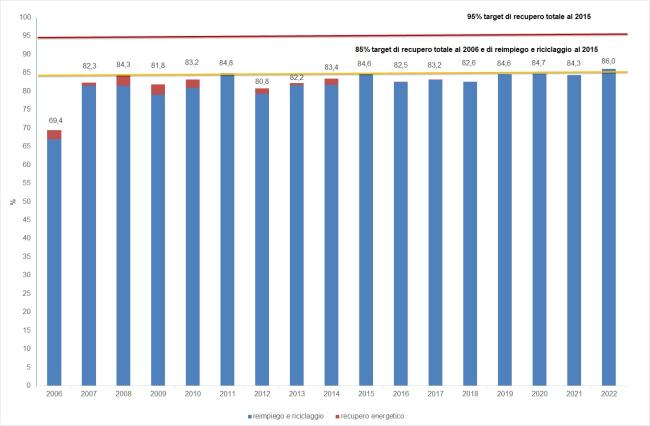Panel 1
Angelo Santini, Fabio Tatti
The analysis of data for 2022 shows a decrease in the quantities recycled/recovered compared to the previous year. The reasons can be attributed to the decline in the number of annual deregistrations certified by the P.R.A. Register of the Ministry of Transport, the international situation that caused delays in the supply of raw materials for automobile manufacturing, and the resulting crisis in the sector, with significant delays in both production and delivery. Overall, the supply chain achieves a reuse and recycling rate of 86% of the vehicle's average weight, exceeding the 85% target set for 2015 by Article 7, paragraph 2 of Legislative Decree 209/2003.
The indicator measures the ratio between the amount reused plus the amount recycled and the total weight of end-of-life vehicles, following the calculation methodology established by Decision 2005/293/EC.
Verify the attainment of the target for preparation for reuse, recycling, and recovery of end-of-life vehicles as established by the applicable legislation.
Directive 2000/53/EC, as amended by Directive 2018/850/EU
By January 1, 2015:
-
Reuse and recovery rate of at least 95% of the average vehicle weight;
-
Reuse and recycling rate of at least 85% of the average vehicle weight per year.
Panel 2
ISPRA - Rapporto Rifiuti Speciali (various edtions)
Data quality assessment
ISPRA (Institute for Environmental Protection and Research)
The data derive from elaborations and estimates based on the information contained in the vehicles section of the single environmental declaration model (MUD).
National
2006-2022
Indicator assessment
The calculation methodology established by Decision 2005/293/EC is based on the analysis of the mass balance between the inputs and outputs of end-of-life vehicle management facilities located throughout the national territory, using data declared by the operators in the vehicles section of the single environmental declaration model (MUD).
In 2022, the supply chain achieves a reuse and recycling percentage of 86% of the average vehicle weight, exceeding the 85% target set for 2015 by Article 7, paragraph 2 of Legislative Decree 209/2003.
Analysis of the trends in reuse, recycling, and recovery percentages since 2006 reveals that, after an initial improvement possibly due to a positive response from the entire supply chain to the new legislation and European targets, as well as a phase of adaptation to the method of reporting information, subsequent years show substantial stability. In 2022, a slight increase (+1.7 percentage points) was recorded, allowing the target set for 2015 (85%) to be reached and exceeded.

The indicator aims to assess the effectiveness of measures taken by Member States to monitor the progress of the transition towards a circular economy. The trend in the values of the indicator recorded from 2006 to the present appears to be largely stable; however, a slight increase in the percentage calculated in 2022 compared to 2021 is noted, enabling the achievement of the 85% target set for 2015 by Article 7, paragraph 2 of Legislative Decree No. 209/2003.
Taking into account the absence of energy recovery treatments, the total recovery rate remains at 86%, still far from the 95% target set by legislation for 2015, although the gap is narrower compared to previous years.
The fluff (light residual material from dismantling) produced by shredding facilities is almost entirely sent for disposal. The difficulty in finding valid destinations for the use of these wastes is one of the major issues of the entire supply chain. It should be noted that proper decontamination of vehicles, given the high calorific value of fluff, which is mainly composed of organic materials, would allow for effective energy recovery. The management challenges observed have therefore persisted over the years, with no progress made in energy recovery, which is widely utilized in other Member States.